KitchenAid KBGN364PSS, KFGR274PSS, KBGN274PSS, KFGR364PSS, KFGR270PSS User Manual
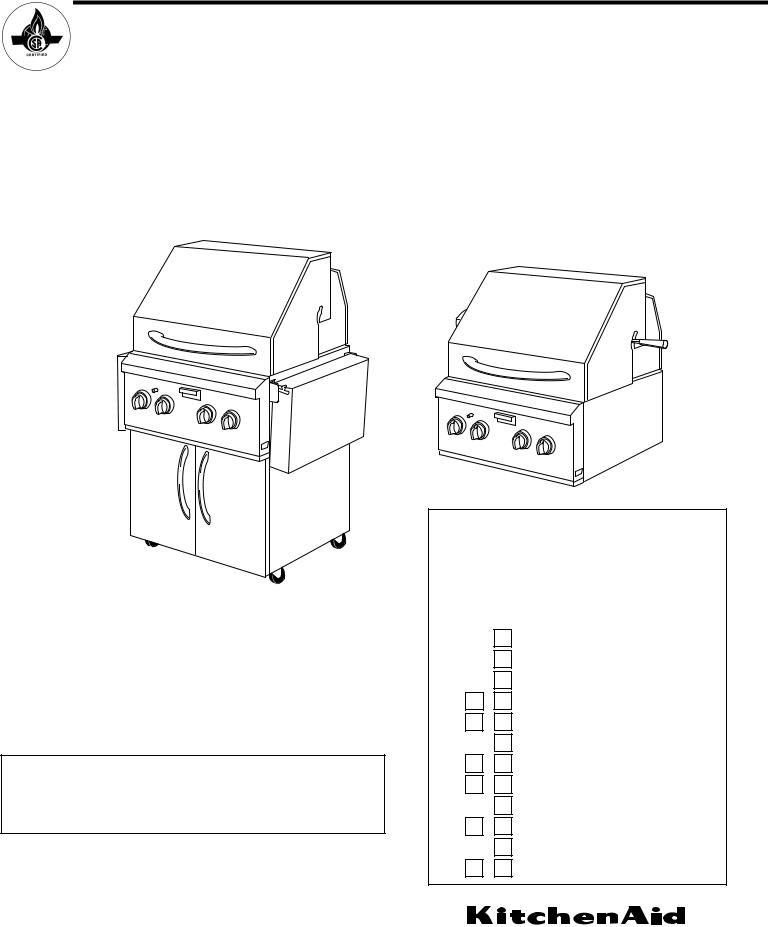
Installation Instructions and
Use and Care Guide
27" (68.6 cm), 36" (91.4 cm), 39" (99.1 cm) and 48" (121.9 cm) Outdoor Grills
(Portable and Built-in — non-combustible construction)
27" (68.6 cm) Portable without rotisserie shown
27" (68.6 cm) Built-In with rotisserie shown
Models
KFGR270PSS
KFGR274PSS
KFGR292PSS
KFGR364PSS
KFGR382PSS
IMPORTANT:
Read and save these instructions.
IMPORTANT:
Installer: Leave Installation Instructions with the consumer.
Consumer: Keep Installation Instructions for future reference.
Save Installation Instructions for local electrical inspector’s use.
Write the model and serial numbers in space provided below before installing or using outdoor grill. The numbers are stamped on the identification label located on the underside of grill drip tray. It is also located on the model/serial number plate, located on heat shield behind control panel close to the smoker box.
Model # ___________________________
Serial # ___________________________
Models
KBGN274PSS
KBGN364PSS
KBGN292PSS
Quick Reference
Table of Contents:
Pages
|
2 |
Before you start |
|
|
Product dimensions |
4 |
4Built-In installation dimensions
5Gas supply requirements
6Rotisserie electrical requirements
7 - 8 Installation steps – Portable models
9- 10 Installation steps – Built-In models
11 Checking/adjusting burners
12 - 14 |
Use and Care Information |
14 - 16 |
Grilling tips & chart |
17 |
Rotisserie tips & chart |
18 - 19 |
Cleaning |
20 |
Warranty |
21 - 22 |
Requesting Assistance or Service |
®
FOR THE WAY IT’S MADE®
Part No. 9758066

Before you start...
Your safety and the safety of others are very important.
We have provided many important safety messages in this manual and on your appliance. Always read and obey all safety messages.
This is the safety alert symbol.
This symbol alerts you to potential hazards that can kill
or hurt you and others.
All safety messages will follow the safety alert symbol and either the word “DANGER” or “WARNING”. These words mean:
 DANGER
DANGER
You can be killed or seriously injured if you don’t immediately follow instructions.
 WARNING
WARNING
You can be killed or seriously injured if you don’t follow instructions.
All safety messages will tell you what the potential hazard is, tell you how to reduce the chance of injury, and tell you what can happen if the instructions are not followed.
FOR YOUR SAFETY
If you smell gas:
1.Shut off gas to the appliance.
2.Extinguish any open flame.
3.Open lid.
4.If odor continues, immediately call your gas supplier or your fire department.
FOR YOUR SAFETY
1.Do not store or use gasoline or other flammable vapors and liquids in the vicinity of this or any other appliance.
2.An L.P. cylinder not connected for use shall not be stored in the vicinity of this or any other appliance.
2
IMPORTANT SAFETY INSTRUCTIONS
1.Do not install portable or built-in grills in or on a recreational vehicle, portable trailer, boat or in any other moving installation.
2.Always maintain minimum clearances from combustible construction, see “Location requirements” section.
3.The outdoor cooking gas appliance shall not be located under overhead combustible construction.
4.This outdoor cooking gas appliance shall be used only outdoors and shall not be used in a building, garage, or any other enclosed area.
5.Keep any electrical supply cord and fuel supply hose away from any heated surfaces.
6.Keep outdoor cooking and appliance area clear and free from combustible materials, gasoline and other flammable vapors and liquids.
7.Do not obstruct the flow of combustion and ventilation air. Keep the ventilation openings of the cylinder enclosure free and clear from debris.
8.Inspect the gas cylinder supply hose before each use of the grill. If the hose shows excessive abrasion or wear, or is cut, it MUST be replaced before using the grill. Contact your dealer and use only replacement hoses specified for use with the grill.
9.Visually check the burner flames. They should be blue. Slight yellow tipping is normal for L.P. gas.
10.Check and clean burner/venturi tube for insects and insect nest. A clogged tube can lead to fire under the grill.
11.The L.P. gas supply cylinder to be used must be:
•constructed and marked in accordance with the Specification for L.P. Gas Cylinders of the U.S. Department of Transportation (DOT) or the National Standard of Canada, CAN/CSA-B339, Cylinders, Spheres, and Tubes for Transportation of Dangerous Goods; and Commission.
•provided with a listed overfilling prevention device.
•provided with a cylinder connection device compatible with the connection for outdoor grill appliances.
12.Always check connections for leaks each time you connect and disconnect the L.P. gas supply cylinder. See “Installation Instructions” section.
13.When the outdoor cooking gas appliance is not in use, the gas must be turned off at the supply cylinder.
14.Storage of an outdoor gas grill appliance indoors is permissible only if the cylinder is disconnected and removed from the outdoor gas grill.
15.Cylinders must be stored outdoors and out of the reach of children and must not be stored in a building, garage, or any other enclosed area.
16.The pressure regulator and hose assembly supplied with the outdoor gas grill must be used. Replacement pressure regulator and hose assembly part number listed in
the “Installation Instructions” section.
17.The cylinder supply system must be arranged for proper vapor withdrawal.
18.Gas cylinder must include a collar to protect the cylinder valve.
WARNING: If the information in this manual is not followed exactly, a fire causing death or serious injury may occur.
If the following information is not followed exactly, a fire causing death or serious injury may occur.
•Do not store a spare LP-gas cylinder under or near this grill.
•Never fill the cylinder beyond 80 percent full.
IMPORTANT:
This grill is manufactured for outdoor use only.
For grills that are to be used at elevations above 2000 feet, orifice conversion is required. See “Gas supply requirements” section.
It is the responsibility of the installer to comply with the minimum installation clearances specified on the model/serial rating plate. The model/serial rating plate can be found on the heat shield behind control panel, close to smoker box.
Copies of the standards listed may be obtained from:
National Fire Protection Association
One Batterymarch Park Quincy, Massachusetts 02269
CSA International
8501 East Pleasant Valley Rd.
Cleveland, Ohio 44131-5575
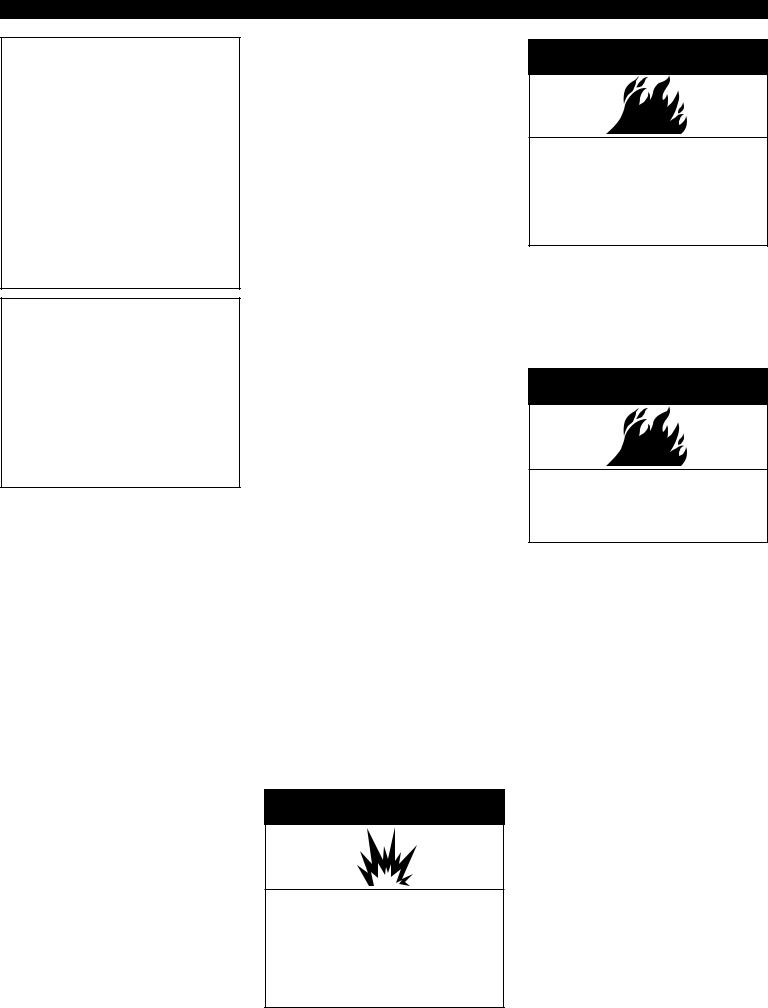
The California Safe Drinking Water and Toxic Enforcement Act requires the Governor of California to publish a list of substances known to the State of California to cause cancer, birth defects, or other reproductive harm, and requires businesses to warn of potential exposure to such substances.
WARNING: This product contains a chemical known to the State of California to cause cancer, birth defects, or other reproductive harm.
This appliance can cause low-level exposure to some of the substances listed, including benzene, crystalline silica, carbon monoxide, toluene, and soot.
In the State of Massachusetts, the following installation instructions apply:
•Installations and repairs must be performed by a qualified or licensed contractor, plumber, or gasfitter qualified or licensed by the State of Massachusetts.
•If using a ball valve, it shall be a T-handle type.
•A flexible gas connector, when used, must not exceed 3 feet.
Tools and parts needed for Built-in (non-combustible construction) installations
•level
•small flat-blade screwdriver
•flat-blade screwdriver
•Phillips screwdriver
•tape measure or ruler
•slip-joint pliers
•pipe wrench
•scissors or cutting pliers to remove tiedowns
Materials required:
•gas line shutoff valve
•1/2" male pipe thread nipple for connection to pressure regulator
•L.P. gas-resistant pipe-joint compound
•AGA or CSA design-certified outdoor flexible stainless steel appliance connector [4-5 ft. (1.2-1.5 m)] or rigid gas supply line as needed
•non-corrosive leak detection solution
Parts supplied
•convertible regulator is set for 4" W.C. natural gas.
Parts needed
The built-in grills are manufactured for use with natural gas.
To convert to L.P./propane gas, Gas Conversion Kit no. 4396311 must be used. Follow Instructions included with kit.
Tools and parts needed for Portable installations
•level
•small flat-blade screwdriver
•flat-blade screwdriver
•Phillips screwdriver
•tape measure or ruler
•slip-joint pliers
•adjustable wrench
•scissors or cutting pliers to remove tiedowns
Materials required:
• non-corrosive leak detection solution
Parts supplied
•hose and regulator assembly set for 11" W.C. L.P. gas (attached to manifold)
•20 lb. L.P. tank (empty) – requires purging and L.P. gas fill by certified L.P. gas fill station
Parts needed
The portable grills are manufactured for use with L.P./Propane gas.
To convert to Natural gas, Gas Conversion Kit no. 4396312 must be used. Instructions included with kit.
•To connect to a fixed L.P./propane gas supply, you must purchase Convertible Regulator Kit No. 4396424 from your dealer.
Location requirements
 WARNING
WARNING
Explosion Hazard
Do not store fuel tank in a garage or indoors.
Do not store grill with fuel tank in a garage or indoors.
Failure to follow these instructions can result in death, explosion, or fire.
 WARNING
WARNING
Fire Hazard
Do not use grill near combustible materials.
Do not store combustible materials near grill.
Doing so can result in death or fire.
Select a location that provides minimum exposure to wind and traffic paths. The location should be away from strong draft areas.
Do not obstruct flow of combustion and ventilation air.
 WARNING
WARNING
Fire Hazard
Do not install this grill on or near combustible materials.
Doing so can result in death or fire.
If you plan to use a combustible enclosure,
return this unit and replace it with the model which is manufactured for use in a combustible enclosure.
Clearance to combustible construction for built-in (non-combustible construction) and portable grills:
A minimum of 12" (30.5 cm) must be maintained between the grill hood, sides and back and any combustible construction. A 12" (30.5 cm) minimum clearance must also be maintained below the cooking surface and any combustible construction.
Rotisserie
If your model is equipped with a rotisserie, 6" (15.2 cm) minimum clearance on each end is needed for the motor and skewer.
A grounded, 3-prong outlet located to the left of the grill is required. (See “Electrical requirements” section.)
3
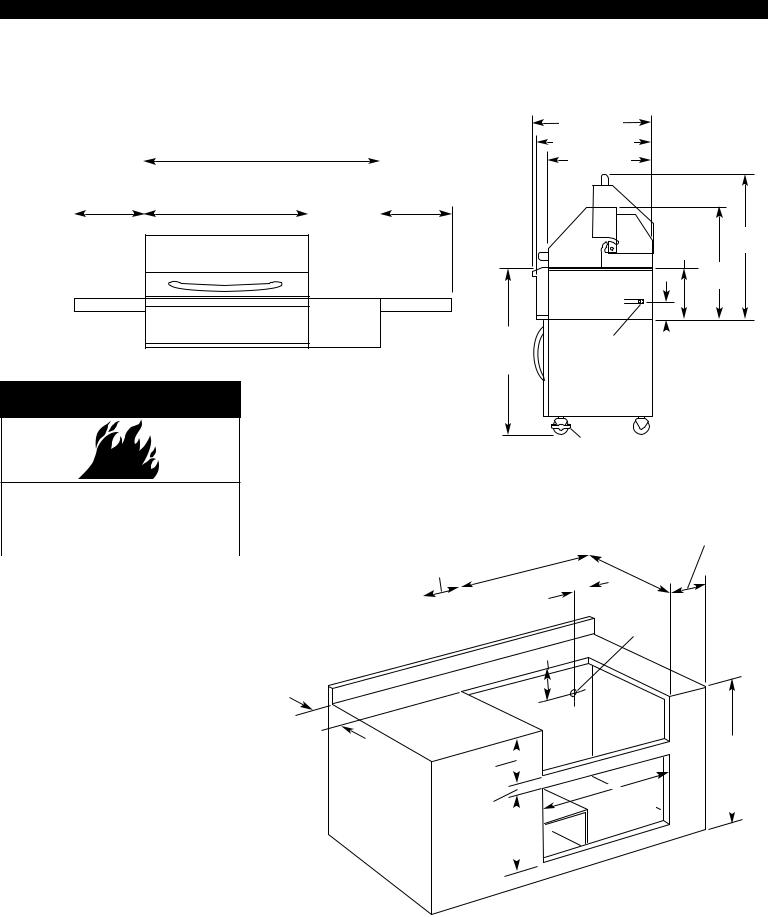
Clearance to combustible construction for built-in (non-combustible construction) and portable grills:
A minimum of 12" (30.5 cm) must be maintained between the grill hood, sides and back and any combustible construction. A 12" (30.5 cm) minimum clearance must also be maintained below the cooking surface and any combustible construction.
Product Dimensions
Portable and |
|
39" (99.1 cm) [27" (68.6 cm) grill with |
|
|
|
|
||||||
|
|
|
|
|
||||||||
Built-in models |
|
|
12" (30.5 cm) side burner] |
|
|
|
|
|||||
|
48" (121.9 cm) [36" (91.4 cm) grill with |
|
|
|
|
|||||||
|
|
|
|
|
|
|
|
|
||||
|
|
|
|
|
|
12" (30.5 cm) side burner] |
|
|
|
|
||
|
|
|
|
|
|
|
|
|
|
|
|
|
|
|
12" |
|
|
|
27" (68.6 cm), or |
|
|
|
|
12" |
|
|
(30.5 cm) |
|
|
36" (91.4 cm) |
|
|
|
(30.5 cm) |
||||
|
|
|
|
|
|
|
|
|
|
|
|
|
|
|
|
|
|
|
|
|
|
|
|
|
|
|
|
|
|
|
|
|
|
|
|
|
|
|
side tray* |
side burner* |
side tray* |
*Not all models have side burner or side trays.
26" (66.0 cm) |
|
|
25-1/2" (64.8 cm) |
|
|
23" (58.4 cm) |
|
|
11-1/8" |
34" |
|
(86.4 cm) |
||
(28.3 cm) |
||
|
24-5/8"
(62.5 cm)
36" |
|
|
|
|
|
|
|
|
|
|
|
||
|
1/2" |
|
|
|
||
(91.4 cm) |
|
|
|
|
||
3-5/8" |
||||||
portable |
|
male NPT |
|
|||
models |
|
|
|
(9.2 cm) |
||
|
|
|
||||
|
|
|
|
|
||
|
|
|
|
|
|
|
 WARNING
WARNING
locking front casters
Fire Hazard |
|
|
|
|
|
|
|
|
|
|
|
|
|
Do not install this grill on or near |
|
|
|
|
|
|
|
|
|
|
|
|
|
combustible materials. |
|
|
|
|
|
|
|
|
|
|
|
|
|
Doing so can result in death or fire. |
12" (30.5 cm) |
|
|
|
|
|
|
|
|
|
|||
|
|
|
|
|
|
|
|
|
|
|
|||
|
|
minimum to |
|
|
|
|
|
|
|
|
22" |
||
|
|
|
|
A |
|
|
|||||||
Built-in Installation |
any accessory |
|
|
|
|
|
|
|
(57.2 cm) |
||||
|
|
|
|
|
|
|
|
|
|
||||
|
|
|
|
|
|
|
|
|
|
|
|
||
|
|
|
2-1/4" |
|
|
|
|
|
|||||
Dimensions |
|
|
|
(5.7 cm) |
|
|
|
|
gas line |
||||
|
|
|
|
|
|
|
|
|
|
rear of grill |
|||
(non-combustible |
|
|
|
|
|
|
|
|
|
|
|
location at |
|
|
|
|
|
7-3/8" |
|
|
|
|
|||||
enclosure) |
|
|
|
|
(18.7 cm) |
|
|
|
|
||||
|
|
|
|
|
|
|
|
|
|
|
|
||
|
|
|
|
|
|
|
|
|
|
|
|
||
|
|
|
|
|
|
|
|
|
|
|
|
||
6" (15.2 cm) min. clearance for rotisserie
IMPORTANT: If grill is to be installed in a combustible enclosure, return this unit and replace it with the model which is manufactured for use in a combustible enclosure.
Enclosure and clearance dimensions that are shown must be used. Given dimensions provide required clearances.
The installation of this grill must conform with the current standards CSA-Z21.58a-1998*, or with local codes.
For installations in a non-combustible enclosure, the grill drops into the opening and is supported by its side flanges. Do not use a bottom support.
2" (5.1 cm) |
|
|
|
|
|
|
|
|
|
|
35-1/2" |
||
|
|
|
|
|
|
|
|
|
|
(90.2 cm) |
|||
minimum to |
|
|
|
|
|
|
|
|
|
|
|||
|
10-7/8" |
|
|
|
|
|
|
|
|
|
|||
open hood |
|
|
|
|
|
|
|
|
|
|
|||
|
|
(27.0 cm) |
|
|
|
|
|
|
|
|
|||
|
|
|
|
|
|
|
|
|
|
|
|||
|
|
|
|
|
|
|
|
|
B |
|
|
|
|
|
|
|
1-1/8" |
|
|
|
|
|
|
||||
|
|
|
|
|
|
optional |
custom |
|
|
||||
|
|
|
(2.9 cm) |
|
|
access doors |
|
|
|||||
|
|
|
|
||||||||||
|
|
|
|
|
|
|
|
|
|
|
|
|
|
counter or support surfaces |
|
|
19" |
|
|
|
|
|
|
||||
|
|
|
(48.3 cm) |
|
|
|
|
|
|
||||
must be level |
|
|
|
|
|
|
|
|
|
||||
|
|
|
|
|
|
|
|
|
|
|
|
|
|
|
|
|
|
|
|
|
|
|
|
|
|
|
|
Non-combustible enclosure installations
Copies of the standards listed may be obtained from:
*CSA International
8501 East Pleasant Valley Rd. Cleveland, Ohio 44131-5575
4
Grill size |
A |
B |
|
|
|
|
|
27" (68.6 cm) |
26" (66.7 cm) |
25-1/4" (64.1 cm) |
|
36" (91.4 cm) |
35" (89.5 cm) |
34-1/4" (87.0 cm) |
|
39" |
(99.1 cm) |
38" (97.2 cm) |
37-1/4" (94.6 cm) |
48" |
(121.9 cm) |
47" (119.4 cm) |
46-1/4" (117.5 cm) |

Gas supply requirements
Observe all governing codes and ordinances.
IMPORTANT: Grill must be connected to a regulated gas supply.
•Input ratings shown on the model/serial rating plate are for elevations up to 2,000 feet (610 m). For elevations above 2,000 feet (610 m), ratings are reduced at a rate of 4% for each 1,000 feet (305 m) above sea level. Orifice conversion is required. Contact KitchenAid Assistance Center.
•Refer to the model/serial rating plate for information on the type of gas that can be used. If this information does not agree with the type of gas available, check with your local gas supplier.
No attempt shall be made to convert the grill from the gas specified on the model/serial rating plate for use with a different gas type without consulting the serving gas supplier. The conversion kits specified must be used.
Line pressure testing:
Testing above 1/2 psi (3.5 kPa) or 14 inches (35.5 cm) W.C. (gauge):
The grill and its individual shutoff valve must be disconnected from the gas supply piping system during any pressure testing of that system at test pressures greater than 1/2 psig (3.5 kPa).
Testing below 1/2 psi (3.5 kPa) or 14 inches (35.5 cm) W.C. (gauge) or lower:
The grill must be isolated from the gas supply piping system by closing its individual manual shutoff valve during any pressure testing of the gas supply piping system at test pressures equal to or less than 1/2 psig (3.5 kPa).
Portable Grills
L.P. Gas:
This grill is equipped for use with an L.P. gas fuel tank. It is design-certified by CSA International for local L.P. gas supply or for Natural gas with appropriate conversion.
L.P. gas from a local L.P. gas supply:
IMPORTANT: The gas installation must conform with local codes, or in the absence of local codes, with the National Fuel Gas Code, ANSI Z223.1/NFPA 54. The qualified L.P. gas technician shall provide the L.P. gas supply to the selected grill location in accordance with the National Fuel Gas Code, NFPA 54 and local codes.
Natural gas conversion:
Conversion must be made by a qualified gas technician. The qualified natural gas technician shall provide the natural gas supply to the selected grill location in accordance with the National Fuel Gas Code NFPA 54 and local codes. For conversion to Natural gas, the Natural gas conversion kit must be used.
IMPORTANT: The gas installation must conform with local codes, or in the absence of local codes, with the National Fuel Gas Code, ANSI Z223.1/NFPA 54.
To convert to Natural gas, the Natural Gas Conversion Kit No. 4396312 must be used. Instructions are included with the kit.
L.P. GAS: Operating pressure:
11 inches (27.9 cm) W.C. Supply pressure: 11 to 14 inches
(27.9 to 35.5 cm) W.C.
NATURAL GAS:
Set pressure 4 inches (10.2 cm) W.C. Supply pressure 7-14 inches
17.8 cm to 35.5 cm) W.C. maximum.
Built-in Grills –
non-combustible construction
Natural Gas:
Built-in grill models are equipped for use with Natural gas. They are design-certified by CSA International for L.P. (propane or butane) gases with appropriate conversion.
Built-in models are set for natural gas use and have a pressure regulator with 1/2" female pipe threads.
The supply line shall be equipped with an approved shutoff valve. This valve should be located in the same area as the grill and should be in a location that allows ease of opening and closing. Do not block access to the shutoff valve. The valve is for turning on or shutting off gas to the appliance.
shutoff valve “open” position
gas supply line
to grill
L.P. gas conversion from a local L.P. gas supply:
Conversion must be made by a qualified gas technician. The qualified natural gas technician shall provide the L.P. gas supply to the selected grill location in accordance with the National Fuel Gas Code NFPA 54 and local codes. To convert to L.P. gas, the L.P. Gas Conversion Kit No. 4396311 must be used. Follow Instructions included with kit.
L.P. gas conversion using a L.P. fuel tank:
To convert to L.P. gas, the L.P. Gas Conversion Kit No. 4396311 must be used. Follow Instructions included with kit.
An L.P. gas cylinder, not larger than 20 pounds, must be purchased separately.
NATURAL GAS:
Set pressure 4 inches (10.2 cm) W.C.
Supply pressure 7-14 inches
17.8 cm to 35.5 cm) W.C. maximum.
L.P. GAS:
Operating pressure:
11 inches (27.9 cm) W.C.
Supply pressure: 11 to 14 inches (27.9 to 35.5 cm) W.C.
5
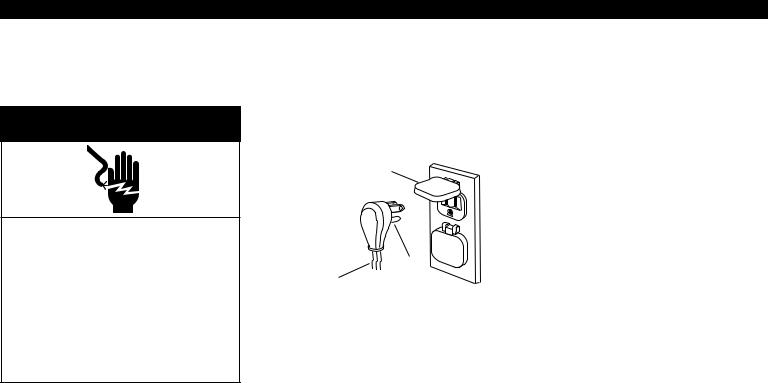
Rotisserie electrical requirements
 WARNING
WARNING
Electrical Shock Hazard
Plug into a grounded 3-prong outlet.
Do not remove ground prong.
Do not use an adapter.
Do not use an extension cord.
Failure to follow these instructions can result in death, fire, or electrical shock.
If codes permit and a separate ground wire is used, it is recommended that a qualified electrician determine that the ground path is adequate.
Check with a qualified electrician if you are not sure whether the grill is properly grounded.
Do not ground to a gas pipe.
A 120-volt, 60-Hz, AC-only, 15-ampere, electrical supply is required.
Recommended ground method
A grounded 3-prong outdoor outlet grounded in accordance with the National Electrical Code ANSI/NFPA 70** or Canadian Electrical Code (C22.1*) — and local codes and ordinances.
3-prong polarized ground-type outdoor outlet
3-prong  ground plug
ground plug
ground prong
power supply cord
Copies of the standards listed above may be obtained from:
*CSA International
8501 East Pleasant Valley Rd. Cleveland, Ohio 44131-5575
**National Fire Protection Association One Batterymarch Park
Quincy, Massachusetts 02269
6
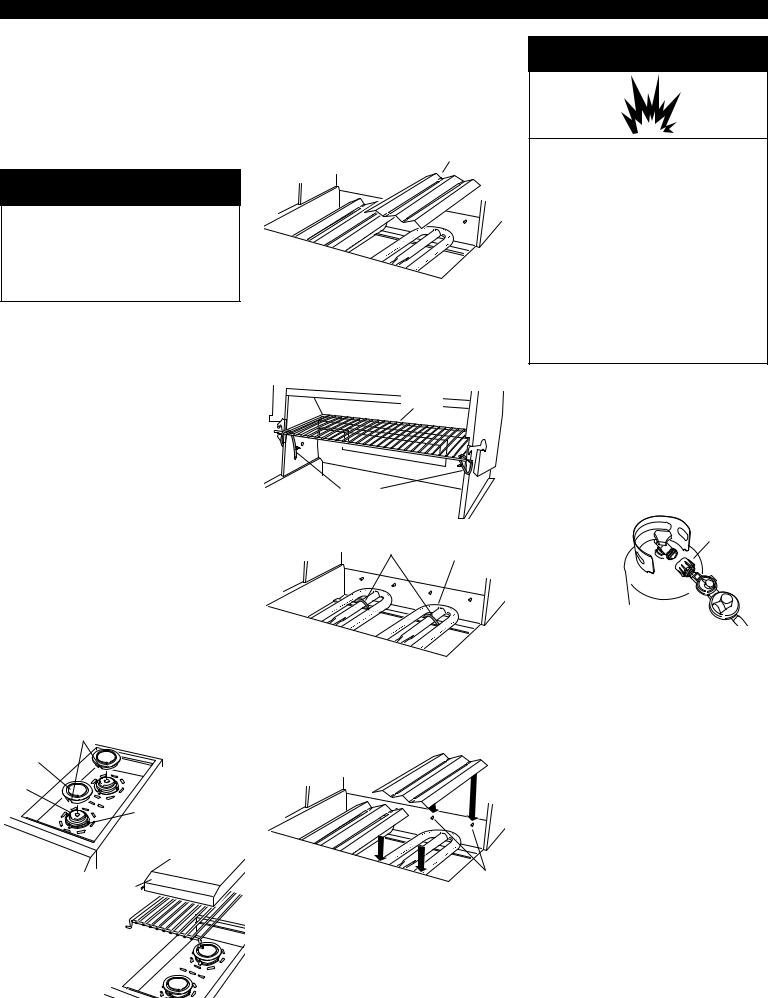
Installation
Instructions —
Portable Outdoor
Grill
 WARNING
WARNING
Excessive Weight Hazard
Use two or more people to move and install grill.
Failure to do so can result in back or other injury.
1. Move grill into desired outdoor location.
2. Open the hood.
3. For models equipped with rotisserie, remove the rotisserie’s skewer from the grill.
4. For models with side burners:
Remove side burner cover from the top of the carton that is located on the grill grate. Remove bubble wrap from side burner cover and set aside.
Open carton located on the grill grate. Remove side burner grate, unwrap and set aside.
Remove burners and burner caps from carton and unwrap. Install each set of burners and caps inside the side burner cavity as shown.
notch
burner cap
burner
 alignment tab
alignment tab
Install side |
cover |
|
burner grate |
||
and cover |
extension |
|
|
||
(with extension |
|
|
toward grill) |
burner |
|
as shown. |
||
grate |
||
Properly dispose |
|
|
of all packing |
|
|
material. |
|
5. Carefully lift off grill grates and set aside.
6. Remove sear plates and set aside.
sear plate
7. Remove tiedowns from burners and warming shelf.
warming shelf
remove tiedowns
remove
tiedowns
burner
8. Reinstall sear plates. Make sure sear plates are resting on pins.
pins
 WARNING
WARNING
Explosion Hazard
Securely tighten all gas connections.
If connected to LP, have a qualified person make sure gas pressure does not exceed 11” (28 cm) water column.
Examples of a qualified person include:
licensed heating personnel, authorized gas company personnel, and
authorized service personnel.
Failure to do so can result in death, explosion, or fire.
9. Make gas connections.
L.P./Propane: A 20 lb. L.P. tank must be purchased separately. Install the tank into the compartment below the grill and screw the hose/regulator assembly to tank as shown.
The pressure regulator and
hose assembly supplied with the grill must
be used. Replacement pressure
regulator and hose assembly specific to your model, is available from your outdoor grill dealer.
If converting to natural gas, see conversion kit requirements and “Gas supply requirements” section. Follow instructions included with kit.
10.Turn on the gas supply. Wait a few minutes for gas to move through the gas line.
11.Test all connections by brushing on an approved non-corrosive leakdetection solution. Bubbles will show a leak. Correct any leak found.
12. Go to “Checking and adjusting the burners” section.
7
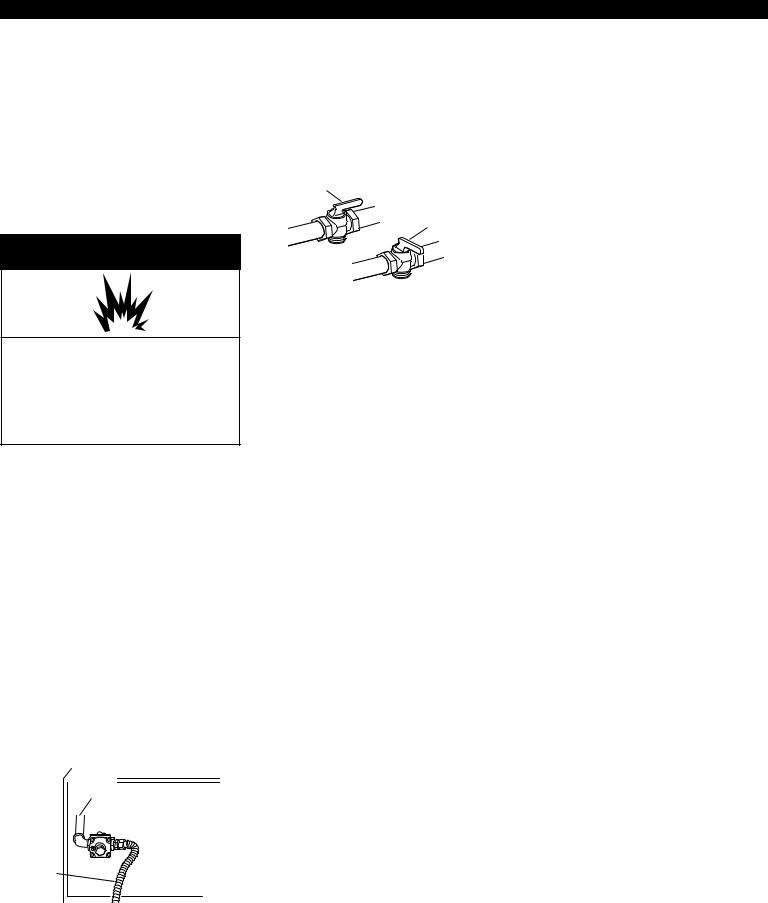
If converted to Natural Gas
Natural Gas Use
This installation must conform with local codes and ordinances**. In the absence of local codes, installations must conform with either the National Fuel Gas Code ANSI Z223.1, or CAN/CGA-B149.1* Natural Gas and Propane installation code.
 WARNING
WARNING
Explosion Hazard
Use a new AGA or CSA approved “outdoor” gas supply line.
Securely tighten all gas connections.
Failure to do so can result in death, explosion, or fire.
1. Make gas connections.
A combination of pipe fittings must be used to connect the grill to the existing gas line.
•If local codes permit, use an outdoor flexible stainless steel tubing gas connector, design-certified by AGA or CSA International, to connect the grill to the rigid gas supply line. 5/8" diameter line is recommended. Using a wrench to tighten, connect the gas supply to the grill. Use pipe joint compound on all nonflared male threads. Do not kink or damage the flexible connector when moving the grill.
•Pipe-joint compounds suitable for use with L.P. gas must be used. Do not use Teflon® tape.
 1/2" grill rear of gas pipe grill
1/2" grill rear of gas pipe grill
flexible gas connector
8
2. Open shutoff valve in the gas supply line. The valve is open when the handle is parallel to the gas pipe.
Test all connections by brushing on an approved non-corrosive leak-detection solution. Bubbles will show a leak. Correct any leak found.
valve open
valve closed
Copies of the standards listed may be obtained from:
*CSA International
8501 East Pleasant Valley Rd. Cleveland, Ohio 44131-5575
**for local codes, contact your local building inspector
®T eflon is a registered trademark of E.I. Du Pont de Nemours and Company.
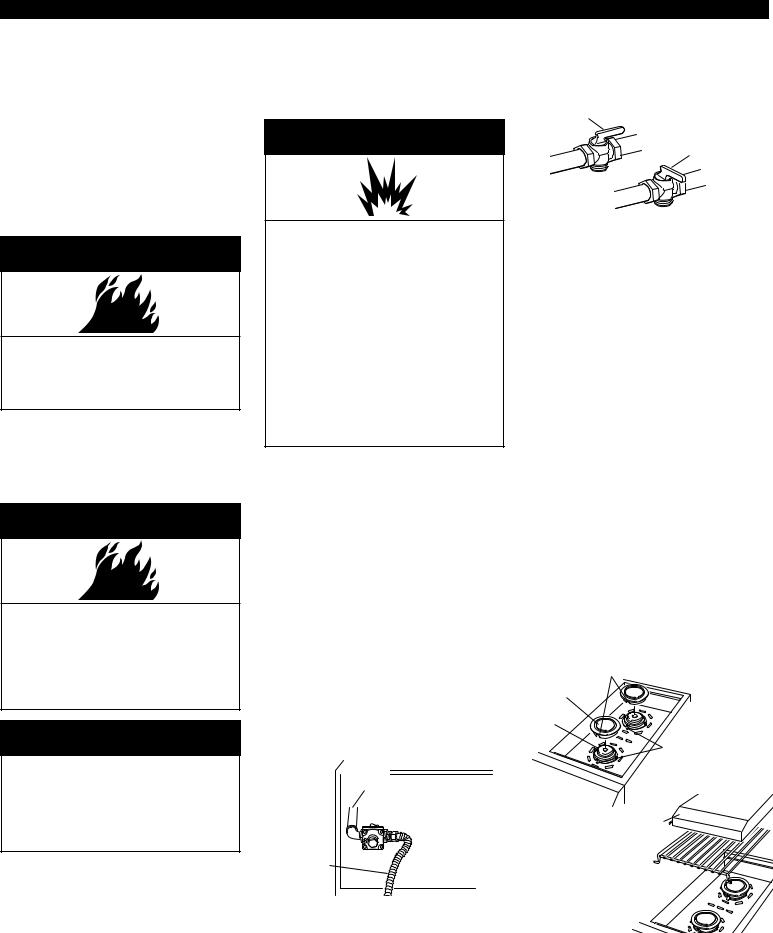
Installation Instructions — Built-In Outdoor Grill (non-combustible construction)
 WARNING
WARNING
Fire Hazard
Do not install this grill on or near combustible materials.
Doing so can result in death or fire.
IMPORTANT: If grill is to be installed in a combustible enclosure, return this unit and replace it with the model which is manufactured for use in a combustible enclosure.
 WARNING
WARNING
Fire Hazard
Do not use grill near combustible materials.
Do not store combustible materials near grill.
Doing so can result in death or fire.
 WARNING
WARNING
Excessive Weight Hazard
Use two or more people to move and install grill.
Failure to do so can result in back or other injury.
Natural Gas Use
This installation must conform with local codes and ordinances**. In the absence of local codes, installations must conform with either the National Fuel Gas Code ANSI Z223.1, or CAN/CGA-B149.1* Natural Gas and Propane installation code.
1. Place grill into outdoor enclosure, but leave enough room in back to connect to gas supply.
 WARNING
WARNING
Explosion Hazard
Securely tighten all gas connections.
If connected to LP, have a qualified person make sure gas pressure does not exceed 11” (28 cm) water column.
Examples of a qualified person include:
licensed heating personnel, authorized gas company personnel, and,
authorized service personnel.
Failure to do so can result in death, explosion, or fire.
2. Make gas connections.
A combination of pipe fittings must be used to connect the grill to the existing gas line.
•If local codes permit, use an outdoor flexible stainless steel tubing gas connector, design-certified by AGA or CSA International, to connect the grill to the rigid gas supply line. 5/8" diameter line is recommended. Using a wrench to tighten, connect the gas supply to the grill. Use pipe joint compound on all nonflared male threads. Do not kink or damage the flexible connector when moving the grill.
•Pipe-joint compounds suitable for use with L.P. gas must be used. Do not use Teflon® tape.
 1/2" grill rear of gas pipe grill
1/2" grill rear of gas pipe grill
flexible gas connector
Copies of the standards listed may be obtained from:
*CSA International
8501 East Pleasant Valley Rd. Cleveland, Ohio 44131-5575
**for local codes, contact your local building inspector
3. Open shutoff valve in the gas supply line. The valve is open when the handle is parallel to the gas pipe.
valve open
valve closed
4. Test all connections by brushing on an approved non-corrosive leakdetection solution. Bubbles will show a leak. Correct any leak found.
5. Open the hood.
6. For models equipped with rotisserie, remove the rotisserie’s skewer from the grill.
7. For models with side burners:
Remove side burner cover from the top of the carton that is located on the grill grate. Remove bubble wrap from side burner cover and set aside.
Open carton located on the grill grate. Remove side burner grate, unwrap and set aside.
Remove burners and burner caps from carton and unwrap. Install each set of burners and caps inside the side burner cavity as shown.
notch
burner cap
burner
|
alignment |
|
|
tab |
|
Install side |
|
|
burner grate |
cover |
|
and cover |
||
extension |
||
(with extension |
|
|
toward grill) |
|
|
as shown. |
burner |
|
|
grate |
|
Properly dispose |
|
|
of all packing |
|
|
material. |
|
®T eflon is a registered trademark of E.I. Du Pont de Nemours and Company.
9

8. Carefully lift grill grates off of grill area and set aside.
9. Remove sear plates and set aside.
sear plate
10. Remove tiedowns from burners and warming shelf.
warming shelf
remove tiedowns
remove
tiedowns
burner
11. Reinstall sear plates. Make sure sear plates are resting on pins.


 pins
pins
12. Carefully slide grill completely into outdoor enclosure.
13. Now go to the "Checking and Adjusting Burners Section."
If converted to
L.P. Gas
 WARNING
WARNING
Explosion Hazard
Securely tighten all gas connections.
If connected to LP, have a qualified person make sure gas pressure does not exceed 11” (28 cm) water column.
Examples of a qualified person include:
licensed heating personnel, authorized gas company personnel, and,
authorized service personnel.
Failure to do so can result in death, explosion, or fire.
1. Make gas connections.
L.P./Propane: A 20 lb. L.P. tank must be purchased separately. Install the tank into the compartment below the grill and screw the hose/regulator assembly to tank as shown.
The pressure regulator and
hose assembly supplied with the grill must be used.
Replacement pressure regulator and hose
assembly specific to your model, is available from your outdoor grill dealer.
If converting to natural gas, see conversion kit requirements and “Gas supply requirements” section. Follow instructions included with kit.
2.Turn on the gas supply. Wait a few minutes for gas to move through the gas line.
3.Test all connections by brushing on an approved non-corrosive leak-detection solution. Bubbles will show a leak. Correct any leak found.
4. Go to “Checking and adjusting the burners” section.
10
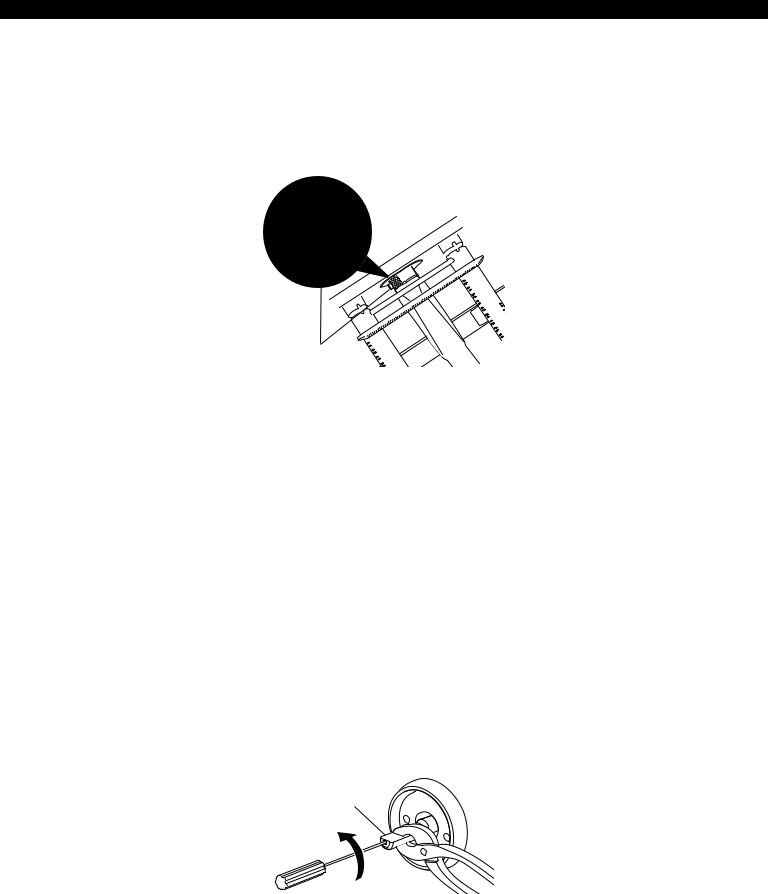
Checking and adjusting the burners
The burners are tested and factory-set for most efficient operation. However, variations in gas supply and other conditions may make minor adjustments to air shutter or low flame setting necessary. Adjustments must be done by a qualified service technician.
NOTE: No adjustment can be made to the rotisserie burner (not used on all models) or smoker tray burner(s).
Checking and adjusting the grill burner flames requires removing the grate and sear plates.
Sear burner flame characteristics:
The flames of the grill burners and surface burners (not used on all models) should be blue and stable with no excessive noise or lifting (L.P./propane gas flames will have a slightly yellow tip). A yellow flame indicates not enough air. If flame is noisy or lifts away from the burner, there is too much air. Some yellow tips on flames when the burner is set to HI setting are acceptable as long as no carbon or soot deposits appear.
Check that burners are not blocked by dirt, debris, insect nests, etc. and clean as necessary. If they are clean, adjust air shutters as needed.
IMPORTANT: Before adjusting air shutters, let burners cool down.
Adjusting the air shutters:
1.Light grill using information in the “Lighting the grill” section.
2.Observe flame to determine which burners need adjustment and how the flame is acting. See “Sear burner flame characteristics” above.
3.Turn off the valve and wait until grill and burners are cool.
4.Remove grill grates, sear plates.
5.Remove burner and loosen air shutter adjustment screw.
a.If flame is yellow (not enough air), turn air shutter counter-clockwise.
b.If flame is noisy or lifts away from burner (too much air), turn air shutter clockwise.
Adjustment should be from 1/8" to 1/4".
air shutter adjustment screw
6.Tighten air shutter adjustment screw.
7.Replace burner sear plates and grates.
8.Ignite burner to check flames. See “Sear burner flame characteristics.”
Repeat Steps 1 through 8 above if needed.
Only adjust the burners that need adjustment.
Low flame adjustment:
If flame goes out on the “LO” setting, the low flame setting must be adjusted.
1.Turn off the valve and wait until grill and burners are cool.
2.Remove grill grates, sear plates.
3.Light grill using information in the “Lighting the grill” section.
4.Turn burner to its lowest setting and remove knob.
5.Hold valve stem with pliers and insert a thin flat-blade screwdriver into the shaft.
6.Watch the flame and slowly turn the screwdriver counter-clockwise.
7.Adjust flame to minimum stable flame.
valve stem
8.Replace the control knob and turn off the burner.
9.Repeat Steps 3 through 8 for each burner if needed.
10.Replace the sear plates and grates after the burners have cooled.
11
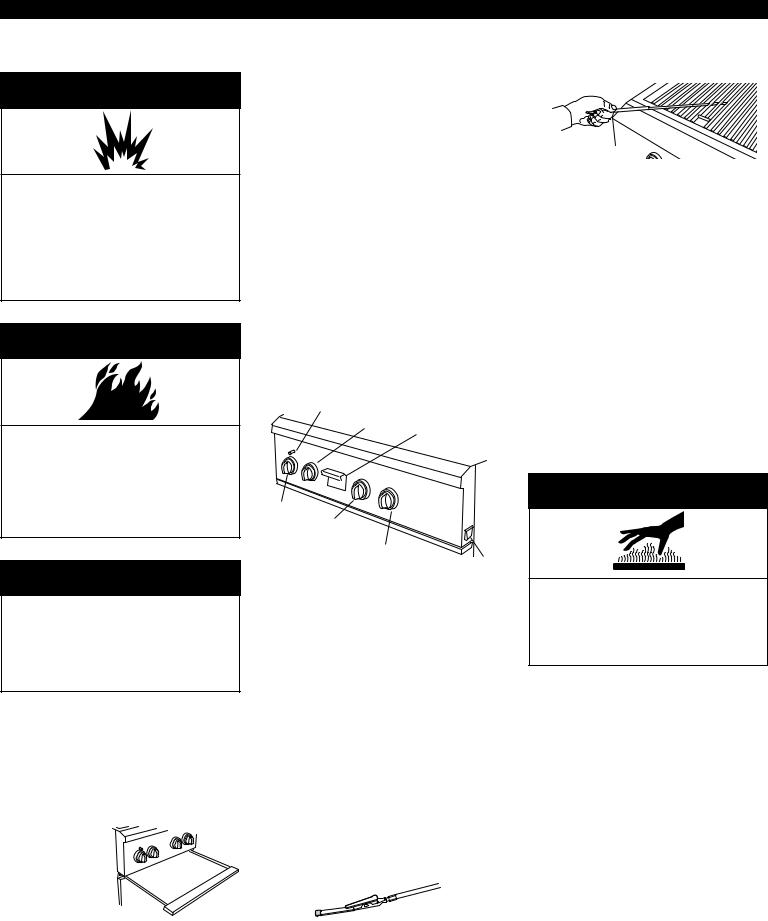
Grill Use
 WARNING
WARNING
Explosion Hazard
Do not store fuel tank in a garage or indoors.
Do not store grill with fuel tank in a garage or indoors.
Failure to follow these instructions can result in death, explosion, or fire.
 WARNING
WARNING
Fire Hazard
Do not use grill near combustible materials.
Do not store combustible materials near grill.
Doing so can result in death or fire.
 WARNING
WARNING
Food Poisoning Hazard
Do not let food sit for more than one hour before or after cooking.
Doing so can result in food poisoning or sickness.
Using your grill
Prepare the gas supply
1.Open the hood completely. Do not light burners with the hood closed.
2.Make sure
control knobs are |
|
|
turned to OFF. |
|
|
The drip pan |
drip pan |
|
must be in place |
||
|
||
and pushed all |
|
|
the way to the |
|
|
back. |
|
Turn the gas supply on:
1.For portable grills using an L.P./ propane gas cylinder:
Slowly open the cylinder valve; do not “snap” open.
NOTE: If flow limiting device does activate, your grill may not light. If your grill does light, the flames will be low and will not heat properly. Turn cylinder valve and all control knobs off and wait 30 seconds. After shutting off the cylinder, very slowly open cylinder valve and wait 5 seconds before lighting.
2.For grills using gas supply source other than L.P. gas cylinder:
Turn the shut off valve to open position from the front of gas supply line.
Lighting the grill
red button |
grill burner |
|
control knob smoker |
|
tray |
4.Carefully guide the lit match between the grill grate and one of the slots in the sear plate.
5.Push in and turn the burner knob to “LITE” for the burner closest to the lit match. The burner will light immediately. When burner is lit, turn knob away from “LITE” to desired setting
6.Repeat steps 2 through 5 for each main burner.
7.Replace manual lighting extension inside the drip tray.
IMPORTANT:
If burner does not light immediately, turn the burner knob to “OFF” and wait 5 minutes before relighting.
If any burners do not light after attempting to manually light them, contact the KitchenAid Assistance Center.
Using the side burner
rotisserie |
|
|
|
burner |
smoker tray |
|
|
control |
|
|
|
burner |
|
|
|
knob |
|
|
|
control knob |
grill burner |
|
|
|
|
||
|
|
|
|
|
|
control knob |
ignitor battery |
|
|
|
compartment |
1.Do not lean over burners. Push in and turn to “LITE” the control knob for the burner you wish to use.
You will hear the “snapping” sound of the spark. When burner is lit, turn knob away from “LITE” to desired setting.
Repeat for each of the other burners as needed.
IMPORTANT:
If burner does not light immediately, turn the burner knob to “OFF” and wait 5 minutes before relighting.
Manually lighting main grill burners
1.Remove the manual lighting extension from inside the drip tray.
2.Attach a match to the clip.
3.Strike the match to light it.
 WARNING
WARNING
Burn Hazard
Do not let the burner flame extend beyond the edge of the pan.
Doing so can result in burns.
Remove side burner cover. Do not light burners with the cover on.
Lighting the side burner
1.Do not lean over burners. Push in and turn to “LITE” the control knob for the burner you wish to use.
You will hear the “snapping” sound of the spark. When burner is lit, turn knob away from “LITE” to desired setting. Repeat for the other burners as needed.
IMPORTANT:
If burner does not light immediately, turn the burner knob to “OFF” and wait 5 minutes before relighting.
12
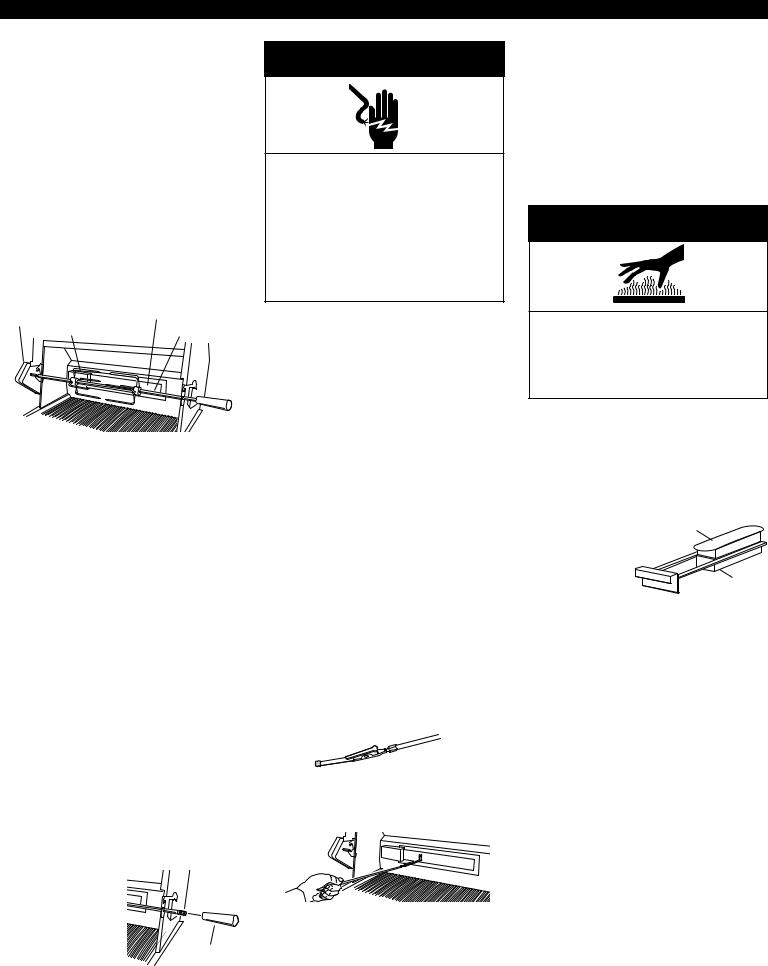
Manually lighting the burners
1.Use a paper match to light the burners.
2.Push in and turn the burner knob to “LITE” for the burner closest to the lit match. The burner will light immediately. When burner is lit, turn knob away from “LITE” to desired setting
IMPORTANT:
If burner does not light immediately, turn the burner knob to “OFF” and wait 5 minutes before relighting.
If any burners do not light after attempting to manually light them, contact the KitchenAid Assistance Center.
Using the rotisserie
motor |
rotisserie |
rotisserie burner |
|
spit rod |
|||
|
fork |
For best cooking results, do not use main grill burners when using the rotisserie.
The rotisserie system is designed to cook food from the rear using intense, searing infrared heat.
1.Remove warming shelf.
2.Mount rotisserie motor on the grill's mounting bracket. Position it securely into support bracket slots.
3.To load the spit rod, slide one of the rotisserie forks onto the spit rod with prongs facing away from handle.
4.Push spit rod through the center of the food, then slide second rotisserie fork into position.
5.Center the food and rotisserie forks on spit rod and tighten wing nuts on the rotisserie forks. If necessary, secure loose food portions with butcher's string only.
6.Once the food is positioned on spit rod, place pointed end of rod into rotisserie motor and lower spit rod onto supports at either side of the grill.
IMPORTANT: On Models KFGR292PSS, KFGR382PSS and KBGN292PSS, remove the handle from the spit rod
when using the side burner. The handle will
get “HOT” and failure to remove it will cause the
handle to crack and melt.
7.Plug single-prong plug into rotisserie motor.
 WARNING
WARNING
Electrical Shock Hazard
Plug into a grounded 3-prong outlet.
Do not remove ground prong.
Do not use an adapter.
Do not use an extension cord.
Failure to follow these instructions can result in death, fire, or electrical shock.
8.Plug 3-prong plug into a grounded 3-prong outlet.
To avoid product damage when not using the rotisserie, remove motor and store indoors. Remove spit rod and forks. Store out of reach of children.
Lighting the rotisserie burner
1.Push in and turn rotisserie burner knob to “LITE”. You will hear a “snapping” sound.
2.Push the red button in.
3.When rotisserie burner lights, continue pressing the red button for another 5 to 10 seconds, and turn knob away from “LITE” to “HI”.
IMPORTANT:
If the rotisserie burner does not light immediately, turn the burner knob to “OFF”, wait 5 minutes before relighting.
Manually lighting rotisserie burner
1.Remove the manual lighting extension from inside the drip tray.
2.Attach a match to the clip.
3.Strike the match to light it.
4.Carefully hold the lit match close to the rotisserie burner.
5.Push in and turn the rotisserie burner control knob to “LITE”.
6.Push in the red button above the rotisserie burner control knob, the burner will light immediately. Hold this button in for 5 to 10 seconds, and turn
knob away from “LITE” to “HI”.
7.Replace manual lighting extension inside the drip tray.
IMPORTANT:
If the rotisserie burner does not light immediately, turn the rotisserie burner control knob to “OFF” and wait 5 minutes before relighting.
Using the smoker box
 WARNING
WARNING
Burn Hazard
Do not remove the smoker box when grill is hot.
Doing so can result in burns.
The smoker tray is designed for easy use. After deciding which wood chips to use, follow the instructions on wood chip packaging. Small size chips or pellets are recommended.
1.Slide box and chip cover out of smoker compartment.
2. Remove cover |
chip cover |
|
|
from box. Turn |
|
cover over and |
|
fill with |
smoker box |
prepared |
|
chips. |
|
3.Turn smoker box over and place over chip cover. Hold cover and box together and turn right side up.
4.Slide box and cover back into smoker compartment after lighting the smoker burner.
Light the smoker burner 5 minutes ahead of time to start it smoking. The speciallydesigned smoker will smoke the food while the grill burners or rotisserie cooks it. Keeping the hood closed as much as possible will maximize the smoking effect.
Lighting the smoker burner
1.Push in and turn smoker burner knob to “LITE”. You will hear a “snapping” sound.
2.When smoker burner lights, turn knob away from “LITE” to “HI”.
IMPORTANT:
If the smoker burner does not light immediately, turn the burner knob to “OFF”, wait 5 minutes before relighting.
13
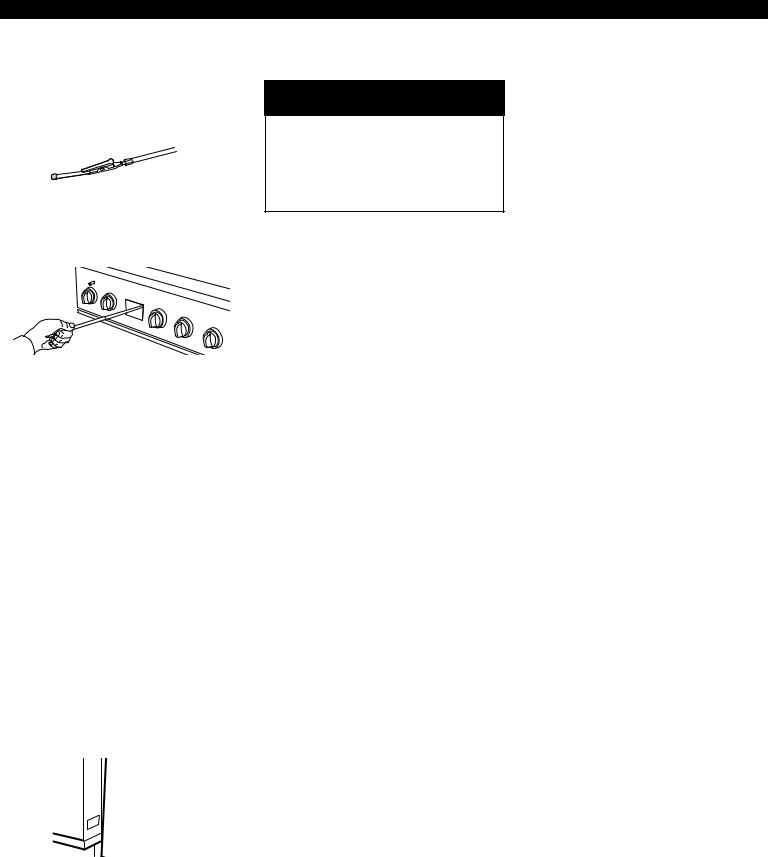
Manually lighting smoker burner
1.Remove smoker tray.
2.Remove the manual lighting extension from inside the drip tray.
3.Attach a match to the clip.
4.Strike the match to light it.
5.Carefully guide the lit match into the smoker chamber area where the tray was removed.
6.Push in and turn the knob for the smoker burner to “LITE”, the burner will light immediately. When the burner is
lit, turn knob away from “LITE” to “HI”.
7.Replace smoker tray.
8.Replace manual lighting extension inside the drip tray.
IMPORTANT:
If the smoker burner does not light immediately, turn the burner knob to “OFF”, wait 5 minutes before relighting.
Always allow box to cool before removal or cleaning.
Grill Care
Replacing the ignitor battery
Your model may have one or two ignitor batteries. If ignitors stop sparking, the battery (or batteries) should be replaced.
1.Lift up at bottom of battery tray and slide battery tray out.
lift up and slide  out tray
out tray
2.Remove battery (or batteries) and replace with alkaline 9-volt battery (or batteries).
3.Slide battery tray back into compartment.
14
Grilling Tips
 WARNING
WARNING
Food Poisoning Hazard
Do not let food sit for more than one hour before or after cooking.
Doing so can result in food poisoning or sickness.
Before Grilling
•Thaw food items before grilling.
•Preheat grill on high (use all grill burners) 7-10 minutes. The hood must be closed during preheating. Do not use back rotisserie burner for preheating. Preheating provides the high heat needed to brown and seal the juices.
•Shorten the preheat time when grilling high-fat cuts of meat or poultry, such as chicken thighs. This will help reduce flare-ups.
•Lightly oil the grill or the food when cooking low-fat cuts of meat, fish or poultry, such as lean hamburger patties, shrimp or skinless chicken breasts.
•Too much oil can cause gray ash to deposit on food.
•Trim excess fat from meats prior to cooking to prevent flare-ups.
•Make vertical cuts at 2" intervals around the fat edge of meat to help prevent the meat from curling while cooking.
•Add seasoning or salt only after the cooking is finished.
During Grilling
•Turn foods only once. Juices are lost when meat is turned several times.
•Turn meat just when juices begin to appear on the surface.
•Avoid puncturing or cutting the meats to test doneness. This allows juices to escape.
•It may be necessary to lower the heat setting for foods that cook a long time or are marinated or basted in a sugary sauce.
•If using a high flame, add barbecue sauce only during the last 10 minutes of cooking to avoid burning the sauce.
•The degree of doneness is influenced by the type of meat, cut of meat (i.e. size, shape and thickness), heat setting selected, and length of time on the grill.
•With the grill cover open the cooking time will be longer.
Smoker Box
The smoker box is a tray that holds wood chips or pellets that provide a smoky flavor when foods are cooked on the grill or rotisserie. For best results the hood should be down for most of the cooking time.
•The amount and size of chips and length of cooking time determine the degree of smoke flavor.
•When using wood chips or wood pellets always follow the package directions. For increased smoking, soak chips in water prior to placing in the smoker box.
Guide to Wood Chips or Pellets:
Alder: A medium, tart smoke taste. Superb on salmon and other fish, chicken or game.
Maple: Sweet, hearty smoke flavor. Best with fish, jerky or bacon.
Apple: A light, sweet flavor. Superb with poultry, ham or sausage.
Hickory: Heavy smoke flavor. Best with beef, pork or game.
Mesquite: A light smoke flavor. Best with fish, poultry or beef.
Oak: Heavy smoke flavor. Best with beef, lamb or pork.
Pecan: A rich, sweet, versatile flavor. Can be used with anything.
Grapevine: A strong smoke flavor. Best with beef or poultry.
Cooking Methods
Direct Heat
Cooking by Direct Heat means the food is placed on grill grates directly above lighted burners. Hood position affects total cooking time.
Direct Heat sears the food. Searing is a process that seals natural juices in food by cooking with intense heat for a short period of time. While juices stay inside, the outside is browned with a flavorful grilled coating.
Indirect Heat
For best results, do not select the Indirect Heat cooking method when it is windy.
Cooking by Indirect Heat means the food is placed on the grill grate above an unheated burner, allowing heat from lighted burner(s) on either side to cook the food.
If possible, turn on two burners. Cook with the hood down. This will shorten the cooking time.
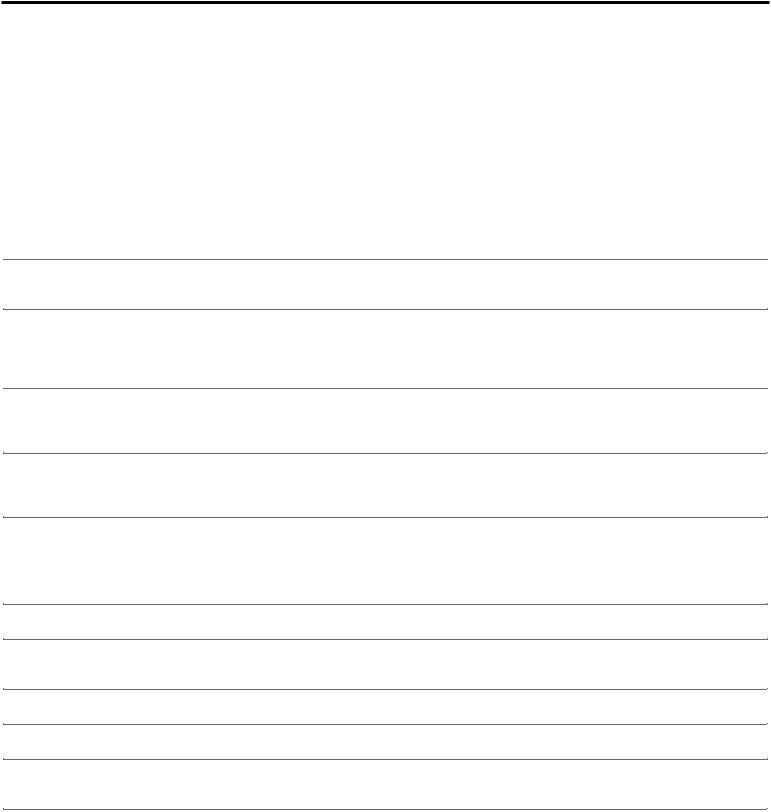
|
|
|
|
|
|
|
Indirect Cooking |
|
|
|
|
|
|
|
|
Burner |
|
|
||
Place food only on the grill grate over the |
|
1 |
2 |
3 |
4 |
|
27" grill |
ON |
OFF |
— |
— |
|
|
OFF burners. |
|
|||||
|
36" grill |
ON |
OFF |
ON |
— |
|
|
|
|
|
|
|
|
Grilling Chart
•Knobs have High, Medium and Low setting for flame adjustment.
•Heat settings indicated are approximate.
•Grilling time based on heating two adjacent burners with food placed on grate between burners (Direct).
•Timings are affected by weather conditions.
•Remove excess fat from edge of chops and steaks. Score remaining fat at 2-inch intervals to prevent curling.
•When 2 temperatures are provided, example: Medium to Medium-Low, start with the first and adjust to how it is cooking.
•Cooking times may vary from chart times depending on the type of fuel, natural gas or L.P..
|
Food |
Cooking Method/ |
Time |
Special Instructions |
|
|
Burner Setting |
|
|||
|
|
|
|
|
|
|
Beef |
|
|
|
|
|
Hamburgers |
DIRECT |
Medium (160°F) |
Grill, turning once. |
|
|
1/2 to 3/4 inch thick |
Medium |
10-15 minutes total |
|
|
|
Roasts |
|
|
|
|
|
Rib Eye, Sirloin |
INDIRECT |
Med-Rare (145°F) to Medium (160°F) |
Tent with foil first 45-60 minutes |
|
|
|
Medium/OFF/Medium |
32-40 minutes per lb. |
of cooking time. |
|
|
Steaks |
|
|
|
|
|
Porterhouse, Rib |
DIRECT |
Med-Rare (145°F) to Medium (160°F) |
Rotate steaks 1/4 turn to create |
|
|
T bone, Top Loin |
Medium |
11-16 minutes total |
criss-cross grill marks. |
|
|
Sirloin |
|
|
|
|
|
1 inch |
|
|
|
|
|
Porterhouse, Rib |
DIRECT |
Med-Rare (145°F) to Medium (160°F) |
|
|
|
T bone, Top Loin |
Medium |
18-25 minutes total |
|
|
|
Sirloin |
|
|
|
|
|
1-1/2 inch |
|
|
|
|
|
Top Round or |
DIRECT |
Med-Rare (145°F) to Medium (160°F) |
|
|
|
Shoulder/Chuck |
Medium |
22-29 minutes total |
|
|
|
(London Broil) |
|
|
|
|
|
1-1/2 inch thick |
|
|
|
|
|
Flank |
DIRECT |
Med-Rare (145°F) |
|
|
|
1/2 inch thick |
Medium |
11-16 minutes total |
|
|
|
Pork |
|
|
|
|
|
Chops, 1 inch thick |
DIRECT |
Medium (160°F) |
|
|
|
|
Medium to Med-Low |
12-20 minutes total |
|
|
|
1-1/2 inch thick |
DIRECT |
Medium (160°F) |
|
|
|
|
Medium to Med-Low |
30-40 minutes total |
|
|
|
Ribs |
INDIRECT |
Medium (160°F) |
Grill, turning occasionally. During last few |
|
|
2-1/2 to 4 lbs. |
Med/OFF/Med |
40-60 minutes total |
minutes brush with barbecue sauce if |
|
|
|
|
|
desired. When done, wrap in foil 1 hour. |
|
|
Roast. Boneless |
DIRECT |
Medium (160°F) |
Turn during cooking to brown on all sides. |
|
|
Tenderloin 1 lb |
Medium |
18-22 minutes total |
|
|
|
Ham, Half |
INDIRECT |
Reheat (140°F) |
Wrap entire ham in foil and put on grill |
|
|
8 to 10 lbs. |
Med/OFF/Med |
2 – 2-1/2 hours total |
without pan or drip pan. |
|
|
Ham Steak |
DIRECT |
Reheat (140°F) |
|
|
|
Precooked |
Preheat Medium |
7-10 minutes total |
|
|
|
1/2 inch thick |
Grill Medium |
|
|
|
|
Hot Dogs |
DIRECT |
Reheat (145°F) |
Slit skin if desired. |
|
|
|
Medium |
5-10 minutes total |
|
|
15
